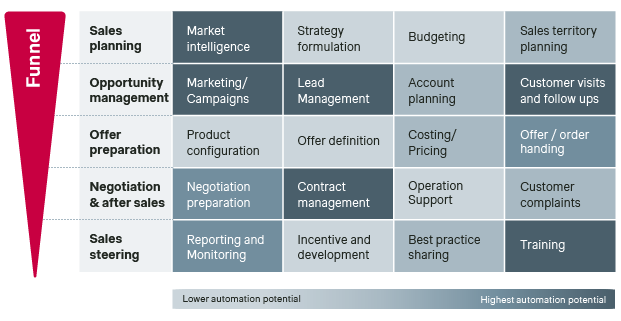Artificial intelligence is redefining how businesses achieve commercial excellence and unlock sustainable growth. In this article, we explore how AI for commercial excellence and growth initiatives can be embedded across strategy, marketing and product, sales, pricing, and vital enablers, so you can turn your investments into measurable results.
Embracing AI for commercial excellence means moving beyond pilots and proofs of concept to fully integrated solutions that power decision-making at every level. Too often, organizations talk about AI-driven transformation without seeing tangible benefits. By refocusing on core commercial processes and applying AI where it delivers the greatest return, you ensure your investments accelerate revenue, optimize operations, and strengthen customer relationships.
The four pillars of commercial excellence
Commercial excellence is built on four interconnected pillars: commercial strategy, marketing & product, sales, and pricing. Each is supported by enabling capabilities. Applying AI thoughtfully across these pillars drives precision in forecasting, personalization in customer engagement, efficiency in sales execution, and discipline in pricing. Below, we expand on how generative AI and advanced analytics fuel each domain to realize both short-term returns and long-term growth.

Image: Commercial Excellence Framework 2025
1. Commercial strategy
Strategic planning benefits greatly from AI-driven insights. Predictive analytics models bring together historical performance data and external market indicators for realistic goal-setting and resource allocation. This foundation of AI for commercial excellence ensures targets are evidence-based rather than aspirational.
Customer and market segmentation become far more granular through machine-learning clustering techniques. These methods uncover high-value micro-segments, reveal usage patterns, and anticipate shifts in buying behavior. In go-to-market planning, simulation engines evaluate demand scenarios, optimize launch timing, and support rapid A/B testing of promotional concepts. Particularly, revenue-model simulations run hundreds of what-if analyses, enabling you to forecast uptake under varying price points, bundles, and distribution strategies. This results in a commercial blueprint aligned to real-world dynamics necessary for accelerated growth.
2. Marketing and product
AI transforms product innovation and marketing into continuous, agile processes. During offer design, generative AI accelerates prototyping via customer feedback, technical constraints, and competitive benchmarks to propose viable product concepts. This rapid iteration cycle reduces time-to-market and ensures product meets exacting customer needs.
When AI evaluates each micro-segment’s willingness to pay, it enables you to craft value propositions that highlight the benefits each group cares about most. In branding and customer experience, natural-language processing customizes messaging and selects optimal channels to reach your audiences. Automated marketing platforms put these insights into action, launching targeted campaigns, generating on-brand creative, and suggesting cross-sell or up-sell offers.
3. Sales
In sales, the impact of AI extends from organizational design to frontline execution. Advanced workforce-analytics tools evaluate territory coverage, rep workloads, and process bottlenecks, guiding resource allocation that maximizes revenue potential. This strategic application of AI for commercial excellence ensures your sales structure supports both efficiency and effectiveness.
Within the sales funnel, AI demonstrates the greatest measurable impact in the following six applications:
- Market intelligence: Continuous competitor monitoring and automated report generation keep your teams informed of market shifts and emerging threats.
- Campaign management: AI refines targeting and timing, ensuring the right message reaches the right audience, thereby boosting response rates and lowering acquisition costs.
- Lead management: Predictive scoring models identify and prioritize high-value prospects, increasing conversion velocity.
- Customer follow-ups: Automated outreach sequences nurture relationships, trigger alerts for human intervention, and maintain momentum throughout the sales cycle.
- Contract management: AI accelerates contract review by flagging non-standard clauses, reducing legal cycle times and minimizing risk.
- Training and coaching: Personalized, on-demand learning paths ingest company manuals to deliver contextual coaching, assessments, and performance feedback around the clock.
Together, these AI-enabled capabilities drive consistent execution, improve win rates, and support scalable growth.

Image: Sales Funnel | AI applications can systematically automate SOPs across the sales funnel (June 2025)
4.Pricing
AI strengthens pricing as a key driver of commercial excellence by forecasting demand elasticity, gauging price sensitivity for each customer segment, and optimizing inventory levels. These capabilities ensure you capture maximum value without sacrificing volume.
Once the pricing strategy is set, dynamic pricing engines take over routine decisions. These recommend optimal prices whenever your data quality and market conditions meet predefined standards, while keeping built-in guardrails in place. During execution, real-time monitoring tools track adherence to your pricing strategy, flag any deviations, and send alerts for quick corrective action. This automated oversight preserves margin integrity and enforces a disciplined approach to pricing governance.
Enabling capabilities for long-term impact
To successfully implement AI for commercial excellence, organizations must build robust enablers:
- Market intelligence: A unified data platform continuously ingests external and internal sources, feeding AI models with up-to-date insights.
- Governance and processes: AI-driven process mapping identifies inefficiencies, prioritizes automation opportunities, and speeds up optimization.
- Talent and capabilities: Structured training and knowledge-sharing programs build AI fluency across teams, ensuring technology adoption aligns with commercial goals.
- KPIs and monitoring: Automated dashboards track key performance indicators in real time, providing leaders with transparent, actionable metrics and minimizing manual reporting burdens.
By reinforcing these enablers, businesses create an adaptive ecosystem where AI realization is not a one-off project but a continuous cycle of insight, action, and refinement.
How Simon-Kucher can help
At Simon-Kucher, we combine deep commercial excellence expertise with advanced AI capabilities to deliver end-to-end solutions. Our cross-functional teams avoid the common pitfall of treating AI as an isolated experiment by aligning every initiative to your organizational culture, governance framework, and growth objectives.
From strategic roadmap development through pilot execution and scale-up, our integrated approach maximizes ROI and accelerates time to value. We guide you in selecting high-impact AI for commercial excellence use cases, tailor algorithms to your data environment, and embed change management to secure adoption across your teams.
Whether you are initiating your AI journey or seeking to enhance existing programs, reach out to our experts to explore how we can help you transform data into decisions and goals into achievements.

